Conservative treatment of idiopathic scoliosis according to FITS concept: presentation of the method and preliminary, short term radiological and clinical results based on SOSORT and SRS criteria
- PMID: 22122964
- PMCID: PMC3286410
- DOI: 10.1186/1748-7161-6-25
Conservative treatment of idiopathic scoliosis according to FITS concept: presentation of the method and preliminary, short term radiological and clinical results based on SOSORT and SRS criteria
Abstract
Background: Conservative scoliosis therapy according to the FITS Concept is applied as a unique treatment or in combination with corrective bracing. The aim of the study was to present author's method of diagnosis and therapy for idiopathic scoliosis FITS-Functional Individual Therapy of Scoliosis and to analyze the early results of FITS therapy in a series of consecutive patients.
Methods: The analysis comprised separately: (1) single structural thoracic, thoracolumbar or lumbar curves and (2) double structural scoliosis-thoracic and thoracolumbar or lumbar curves. The Cobb angle and Risser sign were analyzed at the initial stage and at the 2.8-year follow-up. The percentage of patients improved (defined as decrease of Cobb angle of more than 5 degrees), stable (+/- 5 degrees), and progressed (increase of Cobb angle of more than 5 degrees) was calculated. The clinical assessment comprised: the Angle of Trunk Rotation (ATR) initial and follow-up value, the plumb line imbalance, the scapulae level and the distance from the apical spinous process of the primary curve to the plumb line.
Results: In the Group A: (1) in single structural scoliosis 50,0% of patients improved, 46,2% were stable and 3,8% progressed, while (2) in double scoliosis 50,0% of patients improved, 30,8% were stable and 19,2% progressed. In the Group B: (1) in single scoliosis 20,0% of patients improved, 80,0% were stable, no patient progressed, while (2) in double scoliosis 28,1% of patients improved, 46,9% were stable and 25,0% progressed.
Conclusion: Best results were obtained in 10-25 degrees scoliosis which is a good indication to start therapy before more structural changes within the spine establish.
Figures
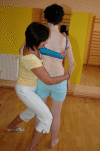






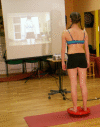




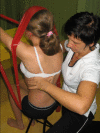





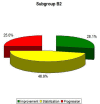

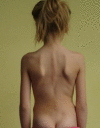
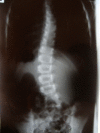
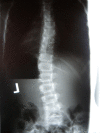

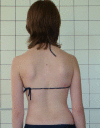
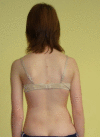

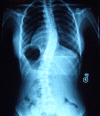

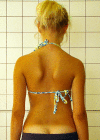
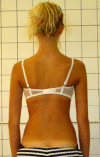
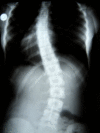
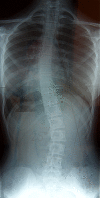

Similar articles
-
Mild angle early onset idiopathic scoliosis children avoid progression under FITS method (Functional Individual Therapy of Scoliosis).Medicine (Baltimore). 2015 May;94(20):e863. doi: 10.1097/MD.0000000000000863. Medicine (Baltimore). 2015. PMID: 25997065 Free PMC article.
-
Effectiveness of complete conservative treatment for adolescent idiopathic scoliosis (bracing and exercises) based on SOSORT management criteria: results according to the SRS criteria for bracing studies - SOSORT Award 2009 Winner.Scoliosis. 2009 Sep 4;4:19. doi: 10.1186/1748-7161-4-19. Scoliosis. 2009. PMID: 19732429 Free PMC article.
-
Brace treatment of Idiopathic Scoliosis is effective for a curve over 40 degrees, but is the evaluation of Cobb angle the only parameter for the indication of treatment?Eur J Phys Rehabil Med. 2019 Apr;55(2):231-240. doi: 10.23736/S1973-9087.18.04782-2. Epub 2018 Mar 7. Eur J Phys Rehabil Med. 2019. PMID: 29517186
-
Physiotherapy scoliosis-specific exercises - a comprehensive review of seven major schools.Scoliosis Spinal Disord. 2016 Aug 4;11:20. doi: 10.1186/s13013-016-0076-9. eCollection 2016. Scoliosis Spinal Disord. 2016. PMID: 27525315 Free PMC article. Review.
-
Correlation of radiographic, clinical, and patient assessment of shoulder balance following fusion versus nonfusion of the proximal thoracic curve in adolescent idiopathic scoliosis.Spine (Phila Pa 1976). 2002 Sep 15;27(18):2013-20. doi: 10.1097/00007632-200209150-00009. Spine (Phila Pa 1976). 2002. PMID: 12634561 Review.
Cited by
-
The Effects of Short- and Long-Term Spinal Brace Use with and without Exercise on Spine, Balance, and Gait in Adolescents with Idiopathic Scoliosis.Medicina (Kaunas). 2022 Jul 29;58(8):1024. doi: 10.3390/medicina58081024. Medicina (Kaunas). 2022. PMID: 36013490 Free PMC article. Clinical Trial.
-
2016 SOSORT guidelines: orthopaedic and rehabilitation treatment of idiopathic scoliosis during growth.Scoliosis Spinal Disord. 2018 Jan 10;13:3. doi: 10.1186/s13013-017-0145-8. eCollection 2018. Scoliosis Spinal Disord. 2018. PMID: 29435499 Free PMC article. Review.
-
Biofeedback Posture Training for Adolescents with Mild Scoliosis.Biomed Res Int. 2022 Jan 31;2022:5918698. doi: 10.1155/2022/5918698. eCollection 2022. Biomed Res Int. 2022. PMID: 35141334 Free PMC article.
-
Physiotherapeutic Scoliosis-Specific Exercise Methodologies Used for Conservative Treatment of Adolescent Idiopathic Scoliosis, and Their Effectiveness: An Extended Literature Review of Current Research and Practice.Int J Environ Res Public Health. 2022 Jul 28;19(15):9240. doi: 10.3390/ijerph19159240. Int J Environ Res Public Health. 2022. PMID: 35954620 Free PMC article. Review.
-
Volumetric and Fatty Infiltration Imbalance of Deep Paravertebral Muscles in Adolescent Idiopathic Scoliosis.Med Sci Monit. 2017 May 2;23:2089-2095. doi: 10.12659/msm.902455. Med Sci Monit. 2017. PMID: 28461686 Free PMC article.
References
-
- Rigo M, Reiter C, Weiss HR. Effect of conservative management on the prevalence of surgery in patients with adolescent idiopathic scoliosis. Pediatr Rehabil. 2003;6(3-4):209–214. - PubMed
-
- Maruyama T, Kitagawa T, Takeshita K, Mochizuki K, Nakamura K. Conservative treatment for adolescent idiopathic scoliosis: can it reduce the incidence of surgical treatment? Pediatr Rehabil. 2003;6(3-4):215–219. - PubMed
-
- Negrini S, Atanasio S, Zaina F, Romano M, Parzini S, Negrini A. End-growth results of bracing and exercises for adolescent idiopathic scoliosis. Prospective worst-case analysis. Stud Health Technol Inform. 2008;135:395–408. - PubMed
-
- Negrini S, Negrini A, Romano M, Verzini N, Parzini S. A controlled prospective study on the efficacy of SEAS.02 exercises in preparation to bracing for idiopathic scoliosis. Stud Health Technol Inform. 2006;123:519–522. - PubMed
LinkOut - more resources
Full Text Sources
Miscellaneous

